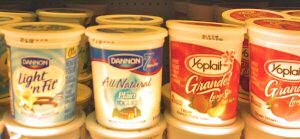
As a person who has never been enthusiastic about buttermilk, sour cream, whipped cream, or cream, I had to teach myself to like yogurt. Back in 1975 when I first tried to eat it (because I had been made aware of its nutritional benefits), it actually made me gag. Gradually, though, I forced myself to sample a little more, and then some more, until I learned to truly love the tart custard-like food.
Many people have not disciplined themselves to eat it, but you are never too old to learn. My father-in-law, J.T.W. Mitchell, now enjoys yogurt. He first tasted it more than a decade ago at age 75.
Often the amazing longevity of some of the residents of Soviet Georgia is attributed to the large quantities of yogurt (and buttermilk) they consume. Yogurt is healthful because it is a good source of calcium and protein; it is easy to digest, even for those who cannot tolerate most dairy products; it is believed to aid in lowering the cholesterol level; and it helps stimulate the body's immune system and to prevent yeast infection. Yogurt can reestablish a colony of friendly bacteria in the intestinal tract after a person has had to take antibiotics. (One negative note: in some individuals yogurt causes sinus congestion.)
Peaceniks, flower children, and back-to-earth people became enamored of the dairy product back in the '60s and 70's, likely making their own batches at home, as I did, in my bought-at-the-health-store yogurt maker. Plain unflavored yogurt is magnificent served topped with bananas, strawberries, peaches, etc. At around 90 calories per cup, plain yogurt is also a quite respectable low-fat substitute for high-fat sour cream.
Unfortunately, a commercially jazzed-up flavored yogurt can ring in at nearly 400 calories, depending upon sweeteners, fillers, and additives used. It's best to beware of the sugared, high-calorie concoctions, and be sure to select a brand containing live bacteria.
To be labeled as yogurt, the product most contain Lactobacillus bulgaricus and Streptococcus thermophilus. (Obviously, these streptococci are good guys; unfortunately, their bad-guy cousins have created a terrible reputation for their family name.) A third especially helpful bacteria, Lactobacillus acidophilus, may also be present.
All these busy bacteria make excellent residents in one's intestines, where they hungrily devour enemy bacteria, thereby serving as microscopic “vacuum cleaners” and purifiers.
So, to instigate a “clean-up campaign” in your interior, start eating feisty yogurt! As a matter of fact, that's not a bad New Year's resolution.
Copyright © 1990–2006 Patricia B. Mitchell.